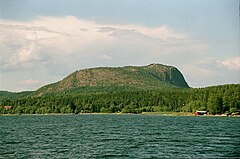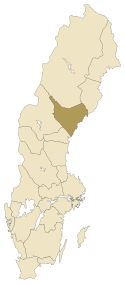Ångermanland
| Prowincja historyczna | |||
 | |||
| |||
| Państwo | |||
|---|---|---|---|
| Kraj | Norrland | ||
| Powierzchnia | 19 800 km² | ||
| Populacja (2013) • liczba ludności | 130 344[1] | ||
| • gęstość | 6,58 os./km² | ||
Położenie na mapie | |||
| 63°20′N 18°00′E/63,333333 18,000000 | |||
Ångermanland – prowincja historyczna (landskap) w Szwecji, położona w Norrland nad Zatoką Botnicką. Graniczy od południa z Medelpad, od zachodu z Jämtland oraz od północy z Lappland i Västerbotten.
Tradycyjne prowincje Szwecji nie pełnią administracyjnych czy politycznych funkcji. Ångermanland w większości leży w regionie administracyjnym Västernorrland, mniejsze części prowincji znajdują się w regionach Västerbotten i Jämtland.
Przypisy
- ↑ Statistiska centralbyrån: Folkmängd i landskapen den 31 december 2013 (szw.). [dostęp 2014-10-16].
Media użyte na tej stronie
Swallow-tailed flag used between the reign of Gustav I of Sweden until c. 1650, when it was succeeded by a triple-tailed flag.
Great coat of arms of Sweden
Autor: Wolfgangus Mozart, Licencja: CC BY-SA 2.5
Location of Ångermanland, historical province of Sweden.
(c) Lokal_Profil, CC BY-SA 2.5
This coat of arms was drawn based on its blazon which – being a written description – is free from copyright. Any illustration conforming with the blazon of the arms is considered to be heraldically correct. Thus several different artistic interpretations of the same coat of arms can exist. The design officially used by the armiger is likely protected by copyright, in which case it cannot be used here.
Individual representations of a coat of arms, drawn from a blazon, may have a copyright belonging to the artist, but are not necessarily derivative works.
Skuleberget






